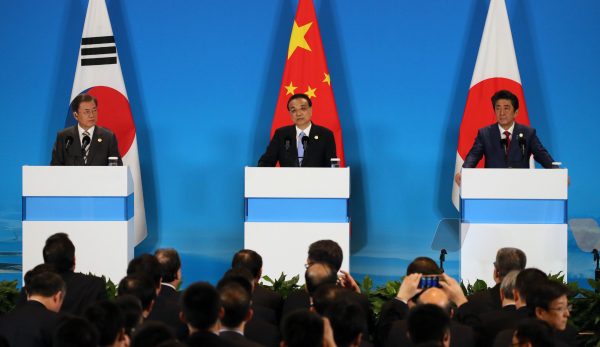Faced with the collapse of cross-border supply chains, the CJK countries might lose their position as a global manufacturing hub. They are also suffering from the devastating halt of intra-regional tourism. There has never been a better time to test the underlying spirit of the December 2019 Chengdu Trilateral Summit. There, the three CJK leaders jointly issued the Trilateral Cooperation Vision for the Next Decade to realise a ‘free, non-discriminatory, transparent, predictable and stable trade and investment environment’ in Northeast Asia.
At the end of February, China and South Korea recorded the first and second-largest number of confirmed cases of COVID-19 in the world respectively. China has since managed to control its domestic spread, but it still has cases imported from overseas. In South Korea, the infection curve has flattened somewhat, but there are still cases of imported infections. Japan is now showing a rising infection curve.
In the two to three months since the pandemic broke out, each CJK country has taken a different approach to fighting the virus. China has relied on sealing its border, mass testing and enforcing regional lockdown. Japan kept its borders open, had targeted testing and loose social isolation. And South Korea also kept borders open but imposed mass testing and loose social isolation.
The CJK countries, as the early ‘whipping boys’, now possess a big database that could be used for improving collective preventive measures, and in much-needed global vaccine development.
The CJK economies are so deeply interconnected that they can easily transmit the virus to each other. They are in the same boat in the fight to contain COVID-19 and stop the free fall of their deeply integrated economies.
The CJK countries first need to extinguish the spreading pandemic wildfire. Only then can they revive supply chains, restore intra-regional travel and ensure financial stability, and engineer a V-shaped economic recovery. Within the agreed Chengdu Summit framework, the CJK trio need to establish trilateral public health and economy ministerial meetings as quickly and frequently as possible to address these urgent collective action agendas.
It’s critical that the CJK countries share accurate and timely data on the spread of COVID-19 in terms of age group, gender and sub-region, and on the effectiveness of isolation policies and treatments. This will help develop better methods to control the virus not only in these three countries, but around the world. The three countries could also collaborate to manufacture medical supplies and equipment, and to keep key components from being subject to export controls.
As the three countries work to contain the coronavirus in the coming months, they need to settle on an ‘exit strategy’ for economic revival, starting with when and how to lift travel restrictions for business travellers and then tourists. They also need to remove tariffs and non-tariff barriers as much as possible to revive supply chains quickly. This will help provide lifelines to small and medium-sized enterprises.
The three countries must also prepare for the potential financial fallout such as international liquidity shortages and exchange rate volatility. Encouragingly, the United States offered currency swap arrangements with nine other economies in March, including South Korea. It might be useful for Korea and Japan to reinstate their currency swap agreement that expired three years ago. Korea and China could also increase the scope of their existing currency swap arrangement.
To counter a looming depression and massive unemployment, most countries are resorting to one of the largest expansionary fiscal and monetary policies in modern times. Beyond country-specific policies for individual economic revival, CJK countries should also coordinate to ensure regional macroeconomic stability.
The ongoing global public health crisis — dubbed ‘the greatest challenge to mankind since World War II’ by UN Secretary General Antonio Guterres — is an opportunity for CJK countries to deepen mutual trust and build confidence. They will undoubtedly succeed in controlling the pandemic in the months ahead. But the three countries must also work to reduce the risk of a second wave of infections. They need to search together for preventive measures against not only this pandemic, but also a variety of possible future disasters resulting from climate change, fine dust, littering and pollution.
The post-COVID-19 world is likely to be a very different one. But a model of collaboration between China, Japan and South Korea, despite lingering historical issues, would offer a silver lining. The three countries should think about how to manage their shared problems collectively now, while they still can.
Choong Yong Ahn is Distinguished Professor at the Graduate School of International Studies, Chung-Ang University, Seoul.
This article is part of an EAF special feature series on the novel coronavirus crisis and its impact.
The themes in this article are drawn from the author’s presentation on 2 April 2020 at the ‘China–Japan–ROK Industrial Cooperation amid Global Spread of the COVID-19’ webinar, organised by China Institute for Reform and Development.

